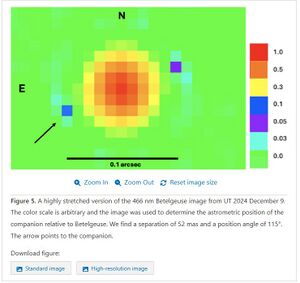Siwarha

This star name was invented by the discoverers[1] of the companion star of Betelgeuse.
Concordance, Etymology, History
In the original paper, the authors suggest the name in the last paragraph:
The name Betelgeuse means “Hand of the Giant,” with “Elgeuse” being a historical Arabic name of the Orion constellation and a feminine name in old Arabian legend. Given that α Ori B orbits the hand of the giant, we suggest that the companion star be named سوارها (Siwarha), or “Her Bracelet.”
The characterisation of the star in the paper reads:
Given the properties of our detection, what could it be? The 466 nm narrowband filter used to observe the companion has a central wavelength similar to that of the standard B filter (445 nm). At the time of the 2024 December observations, the B magnitude of Betelgeuse was approximately B ≈ 2.5 ± 0.1 mag (American Association of Variable Star Observers, AAVSO, and Figure 1). The apparent magnitude of the companion was therefore B ≈ 8.5 ± 1 mag. At a distance of 168 pc, Betelgeuse has an absolute magnitude of MB ≈ −3.6 mag, so the companion would have an absolute magnitude of MB ≈ 2.4 ± 1 mag.
Assuming the two stars are coeval and have an age of 10 Myr, they can be placed on a single-age isochrone to estimate the possible mass range of the stellar companion from its absolute B magnitude. Using the MIST stellar evolution models (B. Paxton et al. 2011[2], 2013[3], 2015[4], 2018[5]; J. Choi et al. 2016[6]; A. Dotter 2016[7]), we generate a 10 Myr solar metallicity stellar evolution isochrone for the system (Figure 7). On the isochrone, Betelgeuse has a mass of ∼20 M⊙, which is in agreement with the other works. At an absolute magnitude of MB ∼ 2.4 mag, the companion has an effective temperature and mass of Teff ∼ 7400 K and M ∼ 1.6 M⊙, respectively. The absolute B magnitude of the companion is uncertain by at least 1 magnitude, so the companion could be as massive as ∼2 M⊙(Teff ∼ 10,000 K) or as small as ∼1.4 M⊙(Teff ∼ 6000 K).
Obviously, they only measured the B magnitude while the V magnitude is roughly 2 mag brighter. As the Bmag is estimated to B ≈ 8.5 ± 1 mag, the visible magnitude should be V ≈ 6.5 ± 1 mag, at the edge of detectability for the human eye, if the star was not always close to the bright red supergiant. WGSN lists it among its "faint star catalog".
Mythology
al-Jawzā is an ancient Arabian femail giant, placed in the sky in the area of Gem, CMi and Ori. Her hand is seen at the star Betelgeuse. According to the legend, al-Jawza is a woman who was promised to the man Suhayl (Canopus) but died on her wedding night, leading her to become a celebrated constellation. The name al-Jawza means "the middle one" or "the giant" and originally referred to the three bright stars in the middle of the figure before it evolved into a full human figure. The legend's characters expand to include Suhayl's two sisters, ash-Shi'rayan, who lived across the river, forming a celestial complex in the night sky.
IAU Working Group on Star Names
The name was discussed and approved by the IAU WGSN in 2025. WGSN adopted it in the IAU-CSN.
Weblinks
Reference
- ↑ Steve B. Howell, David R. Ciardi, Catherine A. Clark, Douglas A. Hope, Colin Littlefield, and Elise Furlan (2025). The Probable Direct-imaging Detection of the Stellar Companion to Betelgeuse, ApJL 988 L47
- ↑ Paxton B., Bildsten L., Dotter A. et al. 2011 ApJS 192 3
- ↑ Paxton B., Cantiello M., Arras P. et al. 2013 ApJS 208 4
- ↑ Paxton B., Marchant P., Schwab J. et al. 2015 ApJS 220 15
- ↑ Paxton B., Schwab J., Bauer E. B. et al. 2018 ApJS 234 34
- ↑ Choi J., Dotter A., Conroy C. et al. 2016 ApJ 823 102
- ↑ Dotter A. 2016 ApJS 222 8




